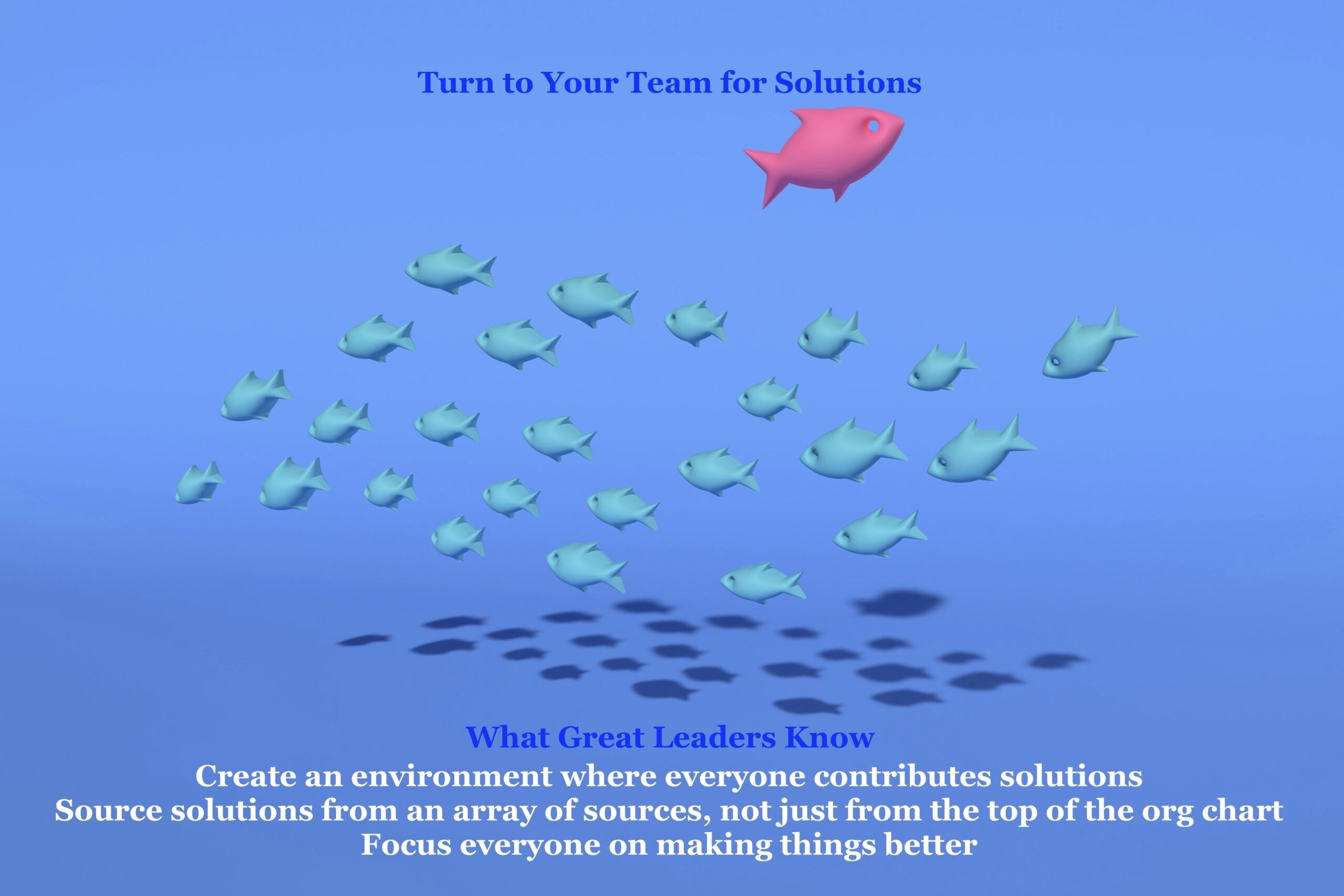Your cart is currently empty!
Tag: Business Quotes

Turn to Your Team for Solutions
Many minds are better than one. Turn to Your Team for Solutions.
Have you ever worked at a job where every decision had to be made by the boss rather than turning to the team for solutions? Asking your team for solutions is a model for growth while single approval control is a misstep. Following the traditional model of business means yielding to the more senior leader as the expert in all circumstances. To be fair, nobody can be an expert at everything or should be expected to be.
Great Leaders know solutions, ideas, innovations come from an array of sources and their role is not to be the one and only solution provider, but the person who creates an environment where everyone has value and is depended upon to contribute to solving problems, innovation, growth.
The obstacle to including team members in decision making is the leader’s need to control. It may seem like the right thing to do is to defer to the boss, but this presents individuals from learning how to make decisions and grow.
When I learned to give problems back to my team, they generated amazing solutions.
Since they were hitting the roadblock day after day, they had a perspective I did not. I made it my goal to engage the team in problem solving. When they would ask me what to do, I asked them what they thought. If they provided a workable solution, I would let them introduce it and give them credit- “We’re going to follow Amy’s plan today.” As you can imagine, Amy’s stock rose among her peers and everyone on the team was motivated to provide the next solution. When other teams spent time gossiping and tuning out, mine were thinking about how can we make things better. Not everyone can offer a workable solution, but that’s not important, engaging them is important.
I remember asking my front line team how we can reduce supply costs. They knew exactly what needed to happen and we reduced supply costs by 20%. They were excited to watch our progress! I was too!
By turning to your team for solutions, employee engagement, retention rates and operational performance results will all improve, leaving the controllers in your wake.
What Great Leaders Know
Create an environment where everyone contributes solutions
Source solutions from an array of sources, not just from the top of the org chart
Focus everyone on making things better
Links
https://whatgreatleadersknow.com/
https://hbr.org/2023/03/how-to-equip-your-team-to-problem-solve-without-you

Lead With Confidence
Shaquille O’Neal never has to tell anyone he is really tall (7 feet 1 inch!). Why? Because he knows he is and we can see that he is in person or on TV. What would it be like if he walked around telling everyone he was really tall? Would you be suspicious?
Gold Medalist gymnast Simone Biles doesn’t spend her time telling everyone she meets that she is a champion gymnast. To lead with confidence, she doesn’t need to boast. Why? Because she knows she is and we have seen her in the Olympics. What if you met Simone and she greeted you with a list of her accomplishments? Would it inspire confidence or concern?
Great leaders know they don’t have to tell people they are the boss because they lead with confidence and act accordingly. Their team members understand from observing and interacting that the leader is the leader. Managers who continually stand behind their title have an important lesson to learn- using a title to provide leverage reduces effectiveness.
When a manager regularly says “You have to do what I say because I’m the manager” it is because THEY don’t believe in themselves. Leading with confidence is key because if they don’t believe, the team won’t either. The team still needs to do what the manager says, however, a leader without confidence will be seen as ineffective. This type of behavior will earn compliance- the lowest level of performance.
What Great Leaders Know
- Have confidence in yourself
- There is no need to proclaim you are the leader when you know you are and lead with confidence
- Using a title as leverage weakens the perception of the leader
Photo by Brooke Lark on Unsplash
Links

Long work to do list? Start with One
What Great Leaders Know- Start With One
Facing a long work to-do list? Start with one task to make progress and stay productive. When dealing with a long work to-do list, start with one task at a time.
From 50 things to do to 1
My wife taught me a very valuable lesson to help me in a time of great frustration. I had started a new job and inherited many, many operational issues. Directing 115 front line employees alone was a ridiculous situation and working long hours didn’t help. While I worked on finding another job, I made a list of important things to do. I stopped writing when I reached 50! Frustrated mounted as day after day, I attacked my list, but never made any progress. Amy convinced me to take a different approach- start with one thing from the long work to-do list and when you can get one thing done, expand your list to two and so on.
A long work to-do list can be overwhelming; start with one task at a time to manage stress effectively. I went back to work the next day fixing my 1 issue- payroll. Having improved the payroll process, I moved on and attacked the work schedule. The other things I simply let go until I could get to them, which was hard, but necessary.
Take the Pressure Off
Sticking with the 1 thing approach lifted the weight of the world from my shoulders and I enjoyed my job again because I was doing my best and I could only do what I could do in that circumstance. What I did not expect was our team performing better. But fixing my most important issue was fixing everyone’s most important issue. Everyone benefitted.
Facing overwhelming challenges, like trying to manage 115 employees alone, all we can do is our best. So, act accordingly. Thanks Amy!
What Great Leaders Know- Start with One
Managing a long work to-do list? Start with one priority first.
When we try to do too much we accomplish nothing
Prioritize your actions
Take advice from the wise people you know
Links
https://whatgreatleadersknow.com
https://www.liquidplanner.com/blog/how-to-prioritize-work-when-everythings-1/

Mastering Leadership: Letting go without losing control
What Great Leaders Know- Southern Fried Rock and Micromanaging
I love music. One of my favorite lyrics appears in the song Hold On Loosely written by James Peterik, Jeff Carllisi, and Richard Donald Barnes for the band 38 Special. There is an unexpected leadership message in, of all places, Southern Fried Rock music. When learning to lead without micromanaging, we can take inspiration from different sources. Letting go without losing control, a lesson from an unexpected source.
“Just hold on loosely but don’t let go”
So much meaning from 8 words. For me, they describe being in a healthy relationship. A healthy relationship is crucial in leadership and avoids the pitfalls of micromanaging. By learning to lead without micromanaging, leaders build solid and trustworthy relationships. Letting go without losing control becomes essential.
Trust, commitment, communication, and boundaries
Great Leaders know healthy relationships are based on trust, commitment, communication, and boundaries. Strong relationships are formed in the forge, which is to say, time has been spent strengthening them through the trial. Great Leaders remain committed to their team members who understand they won’t let go at the first sign of trouble or even the second. Mastering the art of letting go without losing control is key.
Micromanaging is toxic
Great Leaders know micromanaging is neither a healthy nor a pleasant experience. Many managers rely on micromanaging regularly. Faced with a challenge, they return to their default setting, if you want something done right… but this will not work and drives a wedge into the relationship. Micromanaging or over-managing is neither sustainable nor beneficial for the giver or the receiver. Learning to lead without micromanaging is essential to building trust, a two-way street that strengthens the relationship. Great Leaders hold fast but allow for movement. Impeccable communications permit comfort. Thanks to Southern Fried Rock, leaders can learn to manage better. So, remember the importance of letting go without losing control.
What Great Leaders Know
Life lessons can come from unexpected places. Take Southern Fried Rock, for example, which offers insights into leadership and avoiding micromanaging. Thinking about letting go without losing control can provide deeper interpretations.
Strong relationships are formed in the forge, as discussed in both leadership and Southern Fried Rock music. This also applies to the principle of letting go without losing control.
Remain committed to your team members at all times; This shows great leadership and avoids micromanaging.
Micromanaging is destructive for the giver and receiver where trust, is crucial. Learning to lead without micromanaging encourages a healthier work environment and embodies the essence of letting go without losing control.
Links

Great Leadership- Alignment and Mission
We cannot be fulfilled in our work experience if our personal mission is not aligned with our organization’s mission.
When a vehicle is out of alignment, the tires wear out quickly and unevenly delivering an unpleasant ride. Mis-alignment can also damage the breaks, steering and frame. As more time passes without resolving the issue, the more damage is done, the more costly the fix. This is true for Wheels, Alignment and Mission in a professional context as well.
When I have parted ways with employers it has always been because my personal mission no longer aligned with the organization’s mission. Either my personal mission had evolved or I realized the company no longer stood for what I supported. These moments are clear indicators when the focus on Wheels, Alignment and Mission is absent.
I encourage everyone I work with to sit down and write their personal mission statement so they have a North Star. Next, to write down their employer’s mission statement. Compare them. Do they align? Does working for the employer help them achieve their personal mission? How do the leaders of their employer behave in relation to the mission? Is the mission an afterthought, a slogan? Alignment in Wheels, Alignment and Mission is key.
If your employer’s mission or the way they pursue it, doesn’t align with your personal mission, find an organization that does as soon as you can. You will be much happier and less worn down by the journey. Addressing Wheels, Alignment and Mission can help in finding fulfillment in your career.
What Great Leaders Know
Their personal mission
A personal mission must align with our employer’s mission
Missions with conflicting purposes result in unavoidable strain and waste
Links
https://www.firestonecompleteautocare.com/blog/alignment/is-it-time-for-a-wheel-alignment/